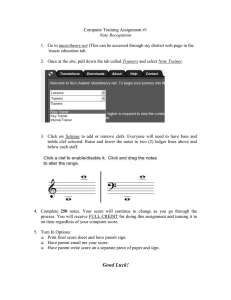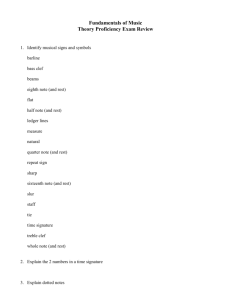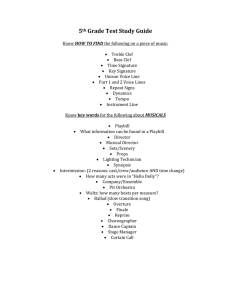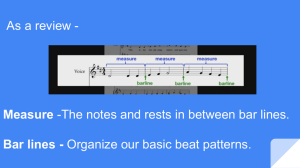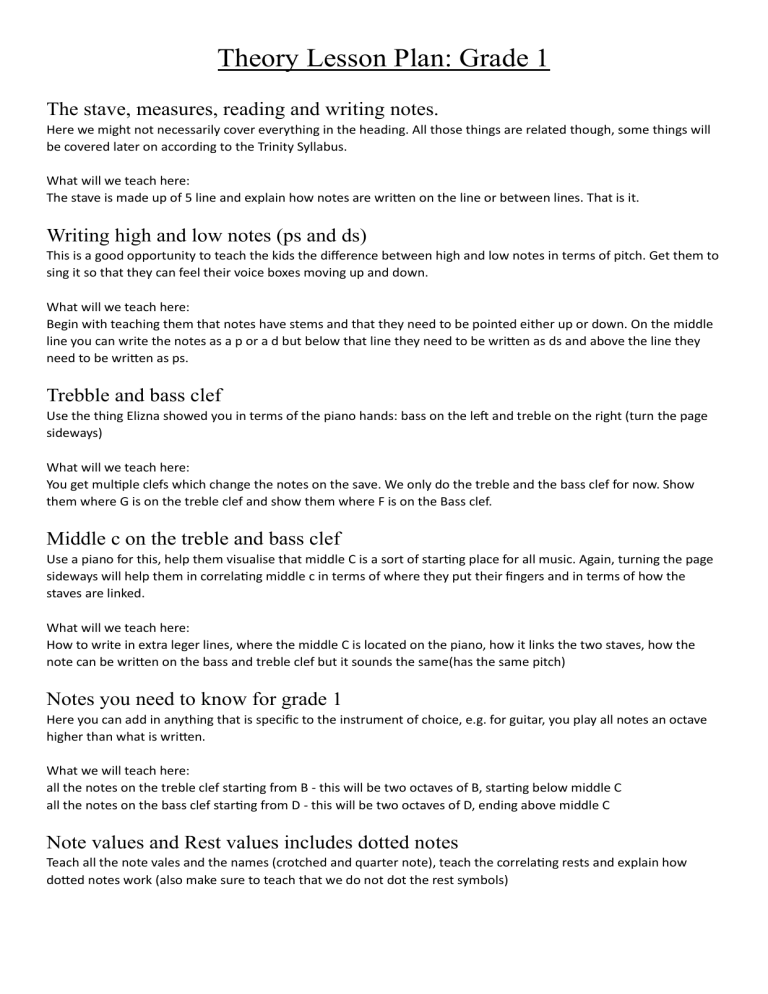
Theory Lesson Plan: Grade 1 The stave, measures, reading and writing notes. Here we might not necessarily cover everything in the heading. All those things are related though, some things will be covered later on according to the Trinity Syllabus. What will we teach here: The stave is made up of 5 line and explain how notes are written on the line or between lines. That is it. Writing high and low notes (ps and ds) This is a good opportunity to teach the kids the difference between high and low notes in terms of pitch. Get them to sing it so that they can feel their voice boxes moving up and down. What will we teach here: Begin with teaching them that notes have stems and that they need to be pointed either up or down. On the middle line you can write the notes as a p or a d but below that line they need to be written as ds and above the line they need to be written as ps. Trebble and bass clef Use the thing Elizna showed you in terms of the piano hands: bass on the left and treble on the right (turn the page sideways) What will we teach here: You get multiple clefs which change the notes on the save. We only do the treble and the bass clef for now. Show them where G is on the treble clef and show them where F is on the Bass clef. Middle c on the treble and bass clef Use a piano for this, help them visualise that middle C is a sort of starting place for all music. Again, turning the page sideways will help them in correlating middle c in terms of where they put their fingers and in terms of how the staves are linked. What will we teach here: How to write in extra leger lines, where the middle C is located on the piano, how it links the two staves, how the note can be written on the bass and treble clef but it sounds the same(has the same pitch) Notes you need to know for grade 1 Here you can add in anything that is specific to the instrument of choice, e.g. for guitar, you play all notes an octave higher than what is written. What we will teach here: all the notes on the treble clef starting from B - this will be two octaves of B, starting below middle C all the notes on the bass clef starting from D - this will be two octaves of D, ending above middle C Note values and Rest values includes dotted notes Teach all the note vales and the names (crotched and quarter note), teach the correlating rests and explain how dotted notes work (also make sure to teach that we do not dot the rest symbols) Bars, bar lines and time signatures (add repeat signs here) Explain what bars are, how they are divided by bar lines, what double bar lines are and repeat signs. Also explain how that ties into time signatures (focusing on 4/4 timing and 3/4 timing) Tones and semi tones Using a piano explain what tones and semi tones are. This is a great opportunity to explain them using other instruments as well. Accidentals Flats, sharps, naturals, double flats and double sharps Keys - C major (tonic or doh) Keys and scales have the same notes (mostly). Go over the tonic (or doh) and explain degrees. Tonic triad in the key of C (C major chord) Explain what triads are and how you get different degrees of triads in a key. The tonic triad is always a major Othe major keys (G & F) here we talk about building scales, TTSTTTS. Use the example of a piano to show that there should be # or b in a key, do it like in the book. Show them where the semi tones should be and then show them how to get them in there. Key Signatures for C, G & F Explain what key signatures are, why they are necessary and how they can help (throw in accidentals here as well and explain how they last for the measure) Intervals Unison, octave, and 2nd, 3rd, 4th, 5th, 6th, 7th (do not worry about major or minor or perfect or augmented) Circle of 5ths Explain how it work in terms of intervals of 5ths and how each time you move over you add a sharp or a flat. You can also go into explaining how it has the relative minor. Use this as the time when you teach your trick. (use Airyn’s) Arpeggios Explain that arpeggios are just broken up chords, played in a melody. At grade one level they need to know a oneoctave arpeggio (1358). Show them that the notes will be either on the line or between the line except for the octave. Then teach the octave principle. Grouping notes and beaming quavers Teach that you beam quavers when together. Teach them how to group the beams (only 1 & 2 and 3 & 4 unless you are in ¾ timing ) Grouping Rests Use a semibreve rest for a whole bar of silence. When using a minim rest the hidden barrier rule still applies - so rather use 2 crotchet rests in those cases. In ¾ timing use crotchet rests rather than minim rests. Answering a given rhythm Use part of the given rhythm as well as variety. So copy some parts, invert the rhythm and make sure the ending feels complete. Ostinato (riffs) Ostinato is a fancy word for riffs. It’s a musical pattern that repeats over and over in a piece. Used a lot in rap and pop music. Musical words and symbols Dynamic markings, articulating marks, tempo marks & repeat signs. pp, p, mp, mf, f, ff crescendo and diminuendo accent, legato, slur, staccato andante - walking pace allego - fast moderato - at a moderate pace ritenuto (rit.) - getting slower. Analysis How to analyse a piece, use this checklist: 1. What is the key 2. What is the tonic of the key (what is the root note) 3. What is the time signature (how many beast are in each bar) 4. Look for any ascending or descending scales in the piece 5. Look for repeat signs or other performance directions. 6. Notice the range of the piece (what is the lowest and highest notes) There will be other things that are not covered in this list, that is where general understanding of sheet music and theory will need to be developed. Different words same meaning (not going to specifically teach this) American and European music will have different names for the same thing Classical and contemporary music will have different names for the same thing.
